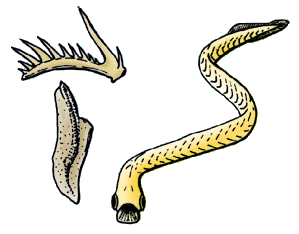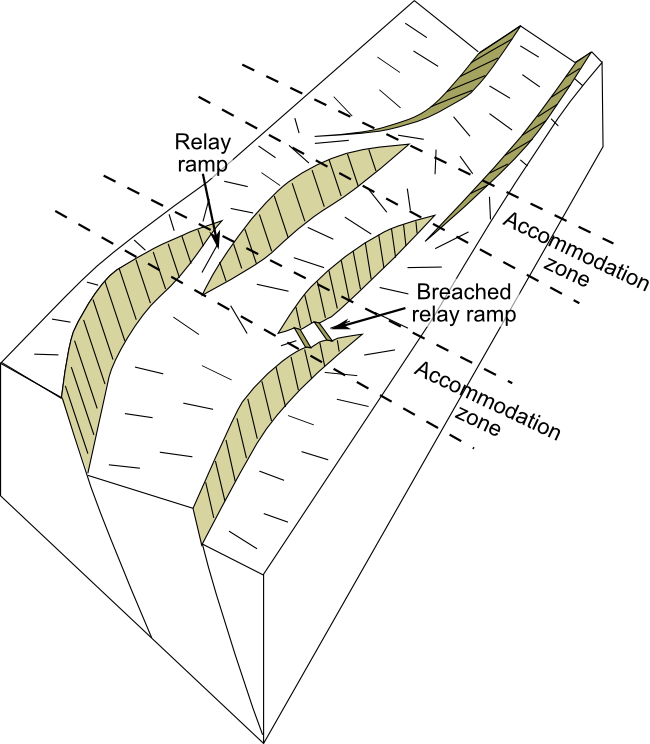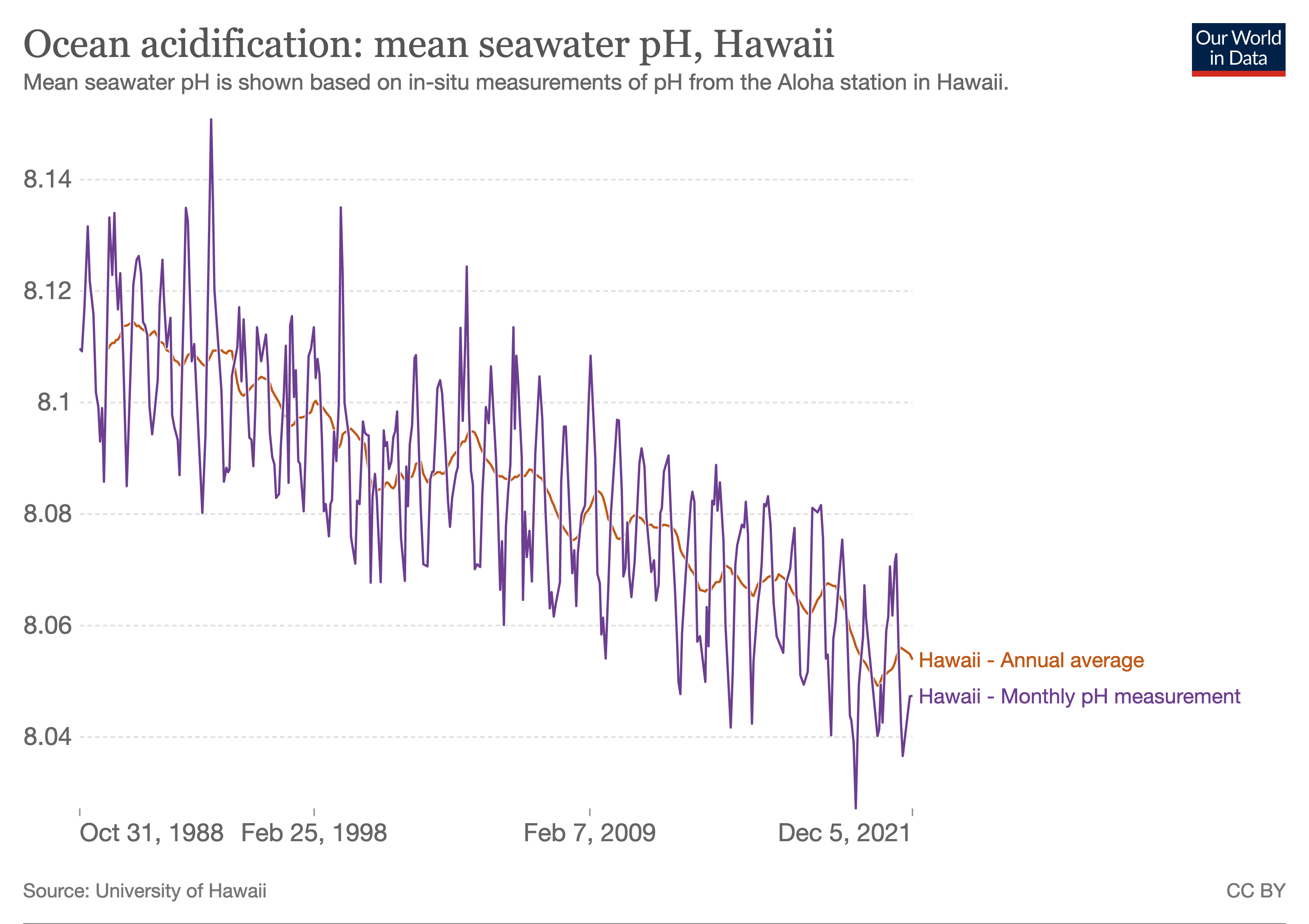|
Jurassic Period
The Jurassic ( ) is a geologic period and stratigraphic system that spanned from the end of the Triassic Period million years ago (Mya) to the beginning of the Cretaceous Period, approximately 143.1 Mya. The Jurassic constitutes the second and middle period of the Mesozoic Era as well as the eighth period of the Phanerozoic Eon and is named after the Jura Mountains, where limestone strata from the period were first identified. The start of the Jurassic was marked by the major Triassic–Jurassic extinction event, associated with the eruption of the Central Atlantic Magmatic Province (CAMP). The beginning of the Toarcian Age started around 183 million years ago and is marked by the Toarcian Oceanic Anoxic Event, a global episode of oceanic anoxia, ocean acidification, and elevated global temperatures associated with extinctions, likely caused by the eruption of the Karoo-Ferrar large igneous provinces. The end of the Jurassic, however, has no clear, definitive boundary with t ... [...More Info...] [...Related Items...] OR: [Wikipedia] [Google] [Baidu] |
International Commission On Stratigraphy
The International Commission on Stratigraphy (ICS), sometimes unofficially referred to as the International Stratigraphic Commission, is a daughter or major subcommittee grade scientific organization that concerns itself with stratigraphy, stratigraphical, geology, geological, and chronology, geochronological matters, worldwide. It is the largest subordinate body of the International Union of Geological Sciences (IUGS). The ICS is essentially a permanent working committee, working subcommittee, which meets far more regularly than the quadrennial meetings scheduled by the IUGS, when it meets as a congress or committee, membership of the whole. Aims One of its main aims, a project begun in 1974, is to establish a multidisciplinary standard and global geologic time scale that will ease paleontology, paleontological and geobiology, geobiological comparisons region to region by benchmarks with stringent and rigorous strata criteria called Global Boundary Stratotype Section and Points ... [...More Info...] [...Related Items...] OR: [Wikipedia] [Google] [Baidu] |
Triassic–Jurassic Extinction Event
The Triassic–Jurassic (Tr-J) extinction event (TJME), often called the end-Triassic extinction, marks the boundary between the Triassic and Jurassic periods, . It represents one of five major extinction events during the Phanerozoic, profoundly affecting life on land and in the oceans. In the seas, about 23–34% of marine genus, genera disappeared; Coral, corals, Bivalvia, bivalves, Brachiopod, brachiopods, Bryozoa, bryozoans, and Radiolaria, radiolarians suffered severe losses of diversity and Conodont, conodonts were completely wiped out, while marine vertebrates, Gastropoda, gastropods, and benthic foraminifera were relatively unaffected. On land, all Archosauromorpha, archosauromorph reptiles other than Crocodylomorpha, crocodylomorphs, dinosaurs, and pterosaurs became extinct. Crocodylomorphs, dinosaurs, pterosaurs, and mammals were left largely untouched, allowing them to become the dominant land animals for the next 135 million years. Plants were likewise significantly a ... [...More Info...] [...Related Items...] OR: [Wikipedia] [Google] [Baidu] |
Dinosauromorpha
Dinosauromorpha is a clade of avemetatarsalians ( archosaurs closer to birds than to crocodilians) that includes the Dinosauria (dinosaurs) and some of their close relatives. It was originally defined to include dinosauriforms and lagerpetids, with later formulations specifically excluding pterosaurs from the group. Birds are the only dinosauromorphs which survive to the present day. Classification The name "Dinosauromorpha" was briefly coined by Michael J. Benton in 1985. It was considered an alternative name for the group "Ornithosuchia", which was named by Jacques Gauthier to correspond to archosaurs closer to dinosaurs than to crocodilians. Although "Ornithosuchia" was later recognized as a misnomer (since ornithosuchids are now considered closer to crocodilians than to dinosaurs), it was still a more popular term than Dinosauromorpha in the 1980s. The group encompassed by Gauthier's "Ornithosuchia" and Benton's "Dinosauromorpha" is now given the name Avemetatarsalia ... [...More Info...] [...Related Items...] OR: [Wikipedia] [Google] [Baidu] |
Ice Caps
In glaciology, an ice cap is a mass of ice that covers less than of land Land, also known as dry land, ground, or earth, is the solid terrestrial surface of Earth not submerged by the ocean or another body of water. It makes up 29.2% of Earth's surface and includes all continents and islands. Earth's land sur ... area (usually covering a highland area). Larger ice masses covering more than are termed ice sheets. Description By definition, ice caps are not constrained by topographical features (i.e., they must lie over the top of mountains). By contrast, ice masses of similar size that ''are'' constrained by topographical features are known as ice fields. The ''dome'' of an ice cap is usually centred on the highest point of a massif. Ice flows away from this high point (the ice divide) towards the ice cap's periphery. Ice caps significantly affect the geomorphology of the area they occupy. Plastic moulding, gouging and other glacial erosional features become prese ... [...More Info...] [...Related Items...] OR: [Wikipedia] [Google] [Baidu] |
Gondwana
Gondwana ( ; ) was a large landmass, sometimes referred to as a supercontinent. The remnants of Gondwana make up around two-thirds of today's continental area, including South America, Africa, Antarctica, Australia (continent), Australia, Zealandia, Arabian Peninsula, Arabia, and the Indian subcontinent. Gondwana was formed by the Accretion (geology), accretion of several cratons (large stable blocks of the Earth's crust), beginning with the East African Orogeny, the collision of India and Geography of Madagascar, Madagascar with East Africa, and culminating in with the overlapping Brasiliano orogeny, Brasiliano and Kuunga orogeny, Kuunga orogenies, the collision of South America with Africa, and the addition of Australia and Antarctica, respectively. Eventually, Gondwana became the largest piece of continental crust of the Paleozoic Era, covering an area of some , about one-fifth of the Earth's surface. It fused with Laurasia during the Carboniferous to form Pan ... [...More Info...] [...Related Items...] OR: [Wikipedia] [Google] [Baidu] |
Laurasia
Laurasia () was the more northern of two large landmasses that formed part of the Pangaea supercontinent from around ( Mya), the other being Gondwana. It separated from Gondwana (beginning in the late Triassic period) during the breakup of Pangaea, drifting further north after the split and finally broke apart with the opening of the North Atlantic Ocean 56 Mya. The name is a portmanteau of Laurentia and Eurasia. Laurentia, Avalonia, Baltica, and a series of smaller terranes, collided in the Caledonian orogeny c. 400 Mya to form Laurussia. Laurussia then collided with Gondwana to form Pangaea. Kazakhstania and Siberia were then added to Pangaea 290–300 Mya to form Laurasia. Laurasia finally became an independent continental mass when Pangaea broke up into Gondwana and Laurasia. Terminology and origin of the concept Laurentia, the Palaeozoic core of North America and continental fragments that now make up part of Europe, collided with Baltica and Aval ... [...More Info...] [...Related Items...] OR: [Wikipedia] [Google] [Baidu] |
Rift
In geology, a rift is a linear zone where the lithosphere is being pulled apart and is an example of extensional tectonics. Typical rift features are a central linear downfaulted depression, called a graben, or more commonly a half-graben with normal faulting and rift-flank uplifts mainly on one side. Where rifts remain above sea level they form a rift valley, which may be filled by water forming a rift lake. The axis of the rift area may contain volcanic rocks, and active volcanism is a part of many, but not all, active rift systems. Major rifts occur along the central axis of most mid-ocean ridges, where new oceanic crust and lithosphere is created along a divergent boundary between two tectonic plates. ''Failed rifts'' are the result of continental rifting that failed to continue to the point of break-up. Typically the transition from rifting to spreading develops at a triple junction where three converging rifts meet over a hotspot. Two of these evolve to t ... [...More Info...] [...Related Items...] OR: [Wikipedia] [Google] [Baidu] |
Pangaea
Pangaea or Pangea ( ) was a supercontinent that existed during the late Paleozoic and early Mesozoic eras. It assembled from the earlier continental units of Gondwana, Euramerica and Siberia during the Carboniferous period approximately 335 million years ago, and began to break apart about 200 million years ago, at the end of the Triassic and beginning of the Jurassic. Pangaea was C-shaped, with the bulk of its mass stretching between Earth's northern and southern polar regions and surrounded by the superocean Panthalassa and the Paleo-Tethys and subsequent Tethys Oceans. Pangaea is the most recent supercontinent to have existed and was the first to be reconstructed by geologists. Origin of the concept The name "Pangaea" is derived from Ancient Greek ''pan'' (, "all, entire, whole") and '' Gaia'' or Gaea (, " Mother Earth, land"). The first to suggest that the continents were once joined and later separated may have been Abraham Ortelius in 1596. The concept that the c ... [...More Info...] [...Related Items...] OR: [Wikipedia] [Google] [Baidu] |
Supercontinent
In geology, a supercontinent is the assembly of most or all of Earth's continent, continental blocks or cratons to form a single large landmass. However, some geologists use a different definition, "a grouping of formerly dispersed continents", which leaves room for interpretation and is easier to apply to Precambrian times. To separate supercontinents from other groupings, a limit has been proposed in which a continent must include at least about 75% of the continental crust then in existence in order to qualify as a supercontinent. Moving under the forces of plate tectonics, supercontinents have assembled and dispersed multiple times in the geologic past. According to modern definitions, a supercontinent does not exist today; the closest is the current Afro-Eurasian landmass, which covers approximately 57% of Earth's total land area. The last period in which the continental landmasses were near to one another was 336 to 175 million years ago, forming the supercontinent Pangaea ... [...More Info...] [...Related Items...] OR: [Wikipedia] [Google] [Baidu] |
Karoo-Ferrar
The Karoo and Ferrar large igneous provinces (LIPs), in Southern Africa and Antarctica respectively, collectively known as the Karoo-Ferrar, Gondwana,E.g. or Southeast African LIP, are associated with the initial break-up of the Gondwana supercontinent at . Its flood basalt mostly covers South Africa and Antarctica, but portions extend further into southern Africa and into South America, India, Australia and New Zealand. Karoo-Ferrar formed just prior to the breakup of Gondwana in the Lower Jurassic epoch, about 183 million years ago; this timing corresponds to the early Toarcian anoxic event and the Pliensbachian-Toarcian extinction. It covered about 3 million km2. The total original volume of the flow, which extends over a distance in excess of 6000 km (4000 km in Antarctica alone), was in excess of 2.5 million km3 (2.5 million cubic kilometres). The Ferrar LIP is notable for long-distance transport and the Karoo LIP for its large volume and chemical diversity. T ... [...More Info...] [...Related Items...] OR: [Wikipedia] [Google] [Baidu] |
Ocean Acidification
Ocean acidification is the ongoing decrease in the pH of the Earth's ocean. Between 1950 and 2020, the average pH of the ocean surface fell from approximately 8.15 to 8.05. Carbon dioxide emissions from human activities are the primary cause of ocean acidification, with Carbon dioxide in Earth's atmosphere, atmospheric carbon dioxide () levels exceeding 422 ppm (). from the atmosphere is absorbed by the oceans. This chemical reaction produces carbonic acid () which dissociates into a bicarbonate ion () and a hydrogen ion (). The presence of free hydrogen ions () lowers the pH of the ocean, increasing acidity (this does not mean that seawater is acidic yet; it is still alkaline, with a pH higher than 8). Marine biogenic calcification, Marine calcifying organisms, such as Mollusca, mollusks and corals, are especially vulnerable because they rely on calcium carbonate to build shells and skeletons. A change in pH by 0.1 represents a 26% increase in hydrogen ion concentration in the ... [...More Info...] [...Related Items...] OR: [Wikipedia] [Google] [Baidu] |
Anoxic Event
An anoxic event describes a period wherein large expanses of Earth's oceans were depleted of dissolved oxygen (O2), creating toxic, euxinic ( anoxic and sulfidic) waters. Although anoxic events have not happened for millions of years, the geologic record shows that they happened many times in the past. Anoxic events coincided with several mass extinctions and may have contributed to them. These mass extinctions include some that geobiologists use as time markers in biostratigraphic dating. On the other hand, there are widespread, various black-shale beds from the mid-Cretaceous which indicate anoxic events but are not associated with mass extinctions. Many geologists believe oceanic anoxic events are strongly linked to the slowing of ocean circulation, climatic warming, and elevated levels of greenhouse gases. Researchers have proposed enhanced volcanism (the release of CO2) as the "central external trigger for euxinia." Human activities in the Holocene epoch, such as t ... [...More Info...] [...Related Items...] OR: [Wikipedia] [Google] [Baidu] |







